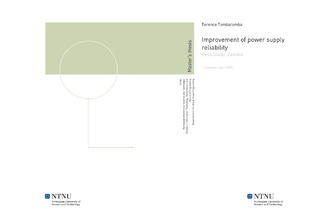Improvement of power supply reliability: Case Study: Zambia
Master thesis
Date
2009Metadata
Show full item recordCollections
- Institutt for elkraftteknikk [2500]
Abstract
This thesis studied reliability of power supply in Zambia following two major power blackouts that affected the whole country. The case study focussed on the generation and transmission network owned by Zambia s biggest utility company Zesco. Three methods of study were selected. The first method looked at the transient stability simulations of Zesco generators when subjected to a large disturbance after a three phase short circuit was applied at three selected buses which are considered critical to the system. The simulations were carried out in SIMPOW. The results show that with fault duration of less than 200 milliseconds, all generators regained synchronism after fault removal. However, extending the fault duration to 200 milliseconds resulted in loss of synchronism in generators at Victoria Falls power station. The second method studied the contingency of some critical components in the Zesco system. The contingency analysis was implemented using software called NETBAS. Study showed that the Zesco system is N-1 stable for contingencies involving transmission lines and transformers. However the system is vulnerable to contingencies involving major power stations such as Kafue gorge and Kariba North bank. The third study proposed modification to the distance protection system to include the effect of zero sequence mutual coupling resulting from parallel circuits following a fault involving earth on a protected line. Adaptive techniques were developed where the settings of the distance relay would change to suit the circuit configuration. This technique resulted in optimal performance of the distance relay under all conditions of parallel line operation. The thesis concludes by making recommendations based on the findings from the studies carried out.
